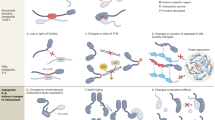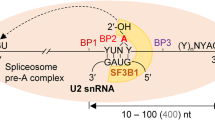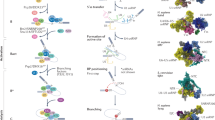Abstract
Splice acceptors with the genomic NAGNAG motif may cause NAG insertion-deletions in transcripts, occur in 30% of human genes and are functional in at least 5% of human genes. We found five significant biases indicating that their distribution is nonrandom and that they are evolutionarily conserved and tissue-specific. Because of their subtle effects on mRNA and protein structures, these splice acceptors are often overlooked or underestimated, but they may have a great impact on biology and disease.
This is a preview of subscription content, access via your institution
Access options
Subscribe to this journal
Receive 12 print issues and online access
$209.00 per year
only $17.42 per issue
Buy this article
- Purchase on Springer Link
- Instant access to full article PDF
Prices may be subject to local taxes which are calculated during checkout

Similar content being viewed by others
References
Garcia-Blanco, M.A., Baraniak, A.P. & Lasda, E.L. Nat. Biotechnol. 22, 535–546 (2004).
Long, M. & Deutsch, M. Mol. Biol. Evol. 16, 1528–1534 (1999).
Ferranti, P., Lilla, S., Chianese, L. & Addeo, F. J. Protein Chem. 18, 595–602 (1999).
Rogina, B. & Upholt, W.B. Biochem. Mol. Biol. Int. 35, 825–831 (1995).
Li, L. & Howe, G.A. Plant Mol. Biol. 46, 409–419 (2001).
Zhang, H.B. & Blumenthal, T. RNA 2, 380–388 (1996).
Sugnet, C.W., Kent, W.J., Ares, M. Jr. & Haussler, D. Pac. Symp. Biocomput. 2004, 66–77 (2004).
Stamm, S. et al. DNA Cell Biol. 19, 739–756 (2000).
Ma, B., Elkayam, T., Wolfson, H. & Nussinov, R. Proc. Natl. Acad. Sci. USA 100, 5772–5777 (2003).
Chen, S., Anderson, K. & Moore, M.J. Proc. Natl. Acad. Sci. USA 97, 593–598 (2000).
Resch, A. et al. J. Proteome Res. 3, 76–83 (2004).
Condorelli, G., Bueno, R. & Smith, R.J. J. Biol. Chem. 269, 8510–8516 (1994).
Karinch, A.M., deMello, D.E. & Floros, J. Biochem. J. 321, 39–47 (1997).
Neves, G., Zucker, J., Daly, M. & Chess, A. Nat. Genet. 36, 240–246 (2004).
Zavolan, M. et al. Genome Res. 13, 1290–1300 (2003).
Acknowledgements
We thank I. Görlich and M.-L. Schmidt for technical assistance. This work was supported by grants from the German Ministry of Education and Research to S.S. and to M.P. as well as from the Deutsche Forschungsgemeinschaft to M.P.
Author information
Authors and Affiliations
Corresponding author
Ethics declarations
Competing interests
The authors declare no competing financial interests.
Supplementary information
Supplementary Table 1
RefSeq entries containing NAGNAG acceptors in the CDS. (XLS 1356 kb)
Supplementary Table 2
Intron phases and splice site scores of human observed and confirmed NAGNAG acceptors. (XLS 22 kb)
Supplementary Table 3
Number of observed and confirmed tandem acceptors for 4 species. (XLS 10 kb)
Supplementary Table 4
Human NAGNAG acceptors in the CDS with a mouse ortholog identified. (XLS 733 kb)
Supplementary Table 5
Pfam domains with a biased distribution between proteins derived from genes with confirmed and without NAGNAG acceptors. (XLS 12 kb)
Supplementary Table 6
Human RefSeq entries with two or three confirmed tandem acceptors in the CDS. (XLS 14 kb)
Rights and permissions
About this article
Cite this article
Hiller, M., Huse, K., Szafranski, K. et al. Widespread occurrence of alternative splicing at NAGNAG acceptors contributes to proteome plasticity. Nat Genet 36, 1255–1257 (2004). https://doi.org/10.1038/ng1469
Received:
Accepted:
Published:
Issue Date:
DOI: https://doi.org/10.1038/ng1469
This article is cited by
-
Pervasive occurrence of splice-site-creating mutations and their possible involvement in genetic disorders
npj Genomic Medicine (2022)
-
Splicing mutations in the CFTR gene as therapeutic targets
Gene Therapy (2022)
-
Alternative splicing landscapes in Arabidopsis thaliana across tissues and stress conditions highlight major functional differences with animals
Genome Biology (2021)
-
Nucleotides in both donor and acceptor splice sites are responsible for choice in NAGNAG tandem splice sites
Cellular and Molecular Life Sciences (2021)
-
Integrative functional genomics decodes herpes simplex virus 1
Nature Communications (2020)



